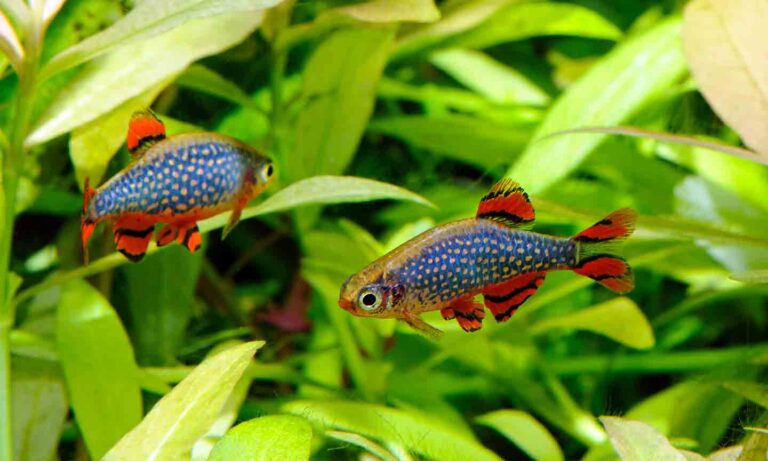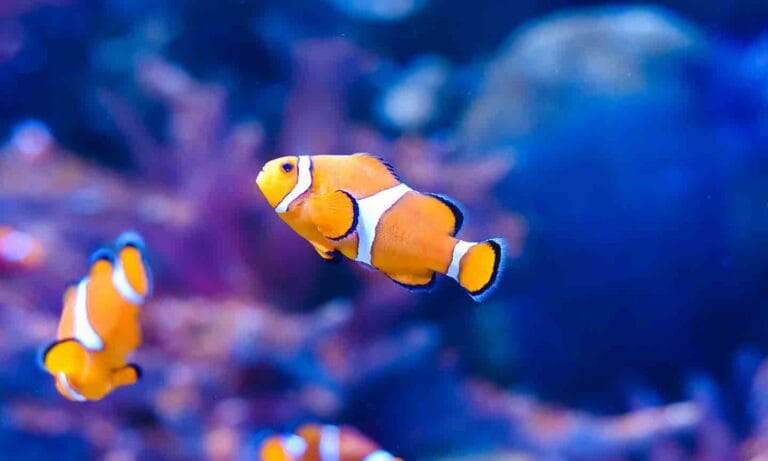One of the oldest and most familiar of the cory catfish is the bronze cory (Corydoras aeneus) in its many forms. Walk into nearly any pet shop in the world, and you will likely find at least one variety. Many (if not most) hobbyists who start out with a community aquarium probably add at least one or two of these industrious little catfish to their setup. Many long-time hobbyists still keep and breed them, helping offset the costs of many hobby-related expenses like fish food, and maybe even the occasional new fish.
Originally imported into the German hobby from the Caribbean island of Trinidad in the early 1900s, the bronze cory soon made its way to the United States, where it became one of the most popular tropical fish. Nearly a century later, this is still true. To add to its popularity, it is available in a variety of colors: natural bronze, bronze with a pinkish overtone around the face, albino, blue-faced albino and golden albino. There are several other wild-type cories that are currently considered locality variants of C. aeneus, though they may eventually turn out to be other species. These include the black aeneus cory and the green, red, orange and gold laser cories. Fortunately, care and breeding for all are about the same.
Corydoras aeneus is long-lived. Fifteen-year-old fish are not uncommon. I’ve had a spawning group that was still actively producing after over 12 years in my aquariums. I still have two of the males from this group that are now well over 25 years old. They quit spawning long ago, but these oldsters still come out eagerly for food and spend much of the day foraging for food, just as they’ve done for their entire lives.
Caring for your bronze cories couldn’t be easier. They are undemanding when it comes to water parameters, as long as extremes are avoided. I’ve had them spawn in hard, alkaline water with a pH near 8, and in soft, acidic water with a pH around 6. Neither seemed to affect fertilization percentages or hatch rates. Temperatures should be kept in the low to mid-70s Fahrenheit, but they can tolerate warmer temperatures into the 80s for short periods of time.
Feeding is also easy. Juvenile and adult bronze cories will take all types of prepared fish foods, as well as most frozen and live foods that are fed to other fish. One thing you should not do is treat them as “scavengers” that will clean up after other fish. They should be properly fed with sinking pellets or frozen fish foods in their own right, not just left to scavenge leftovers from the rest of the occupants of the aquarium. Many hobbyists feed their cories right after the lights are turned off for the day. Another trick is to feed the rest of the fish, then use a piece of PVC pipe to drop pellets unseen by other fish right down to the bottom where the cories will get their own meal undisturbed by other fish.
One of the peculiar behaviors associated with bronze cories is their occasional “winking” at observers. This is actually associated with their quick dashes to the surface to grab a gulp of air. They then settle back to the bottom, and after several seconds they “wink,” moving their eye as part of the motion of forcing the gulp of air into their gut, where the oxygen is extracted.
Bronze cories should be kept in a group of at least six to 12 individuals, depending on the size of the aquarium. They are very social animals and should not be kept singly or in pairs. This causes stress that can lead to a shortened life.
Spawning bronze cories is not too difficult, and most hobbyists should be able to get their adult fish to spawn if they put just a little effort into it. Adult cories are easy to sex. When looking down from above, adult females should be wider behind the dorsal fin, while adult males tend to remain slim in this same area. The ventral fins of males are generally more pointed, while those of females are more paddle-shaped. Lastly, females are generally a bit larger than males, having about 20 percent or so more body mass than males.
Separate the males and females for about a week. Whenever possible, I use a group of four or five males, and two to three females for spawning. Feed them well on meaty foods such as frozen bloodworms, frozen brine shrimp, and even live foods like blackworms, white worms and live brine shrimp. While conditioning the adults, set up a bare 10-gallon aquarium with a mature sponge filter. Fill it about halfway with clean water. This aquarium can have gravel, but it’s not necessary. You can add a couple of spawning mops or a couple of clumps of Java ferns (Microsorum spp.). Add the adults in the evening. It’s best to do this when a storm front is coming through; the changes in barometric pressure seem to be a stimulant for spawning. Turn up the bubbling on the sponge filter to full blast. Maybe even add a second airstone or power fish tank filters to the aquarium to really churn things up. Fill the aquarium with water about 5 degrees cooler than that which is in the aquarium.
The males generally start chasing the females right away. After about two hours, they should begin spawning. The fish assume a “T” position, with the male being the top of the “T” and the female being the base. The female uses her paddle-shaped pelvic fins to form a sort of cup where she catches about three to five eggs. The eggs are fertilized at this point. The exact mechanism of how the sperm gets from the male’s vent to the eggs in the female’s pelvic fin “pouch” is still not fully understood. The female then breaks away from the male and goes off and lays her clutch of eggs. She will clean the spot where she is going to lay them quickly with her mouth, then move up and lay the clump of eggs. Normally this is on the glass sides of the aquarium, but some eggs will also be laid in the plants and/or mops. They might even lay some eggs on the sponge filter. This will be repeated until each female has laid more than 200 eggs. Then all of the adults will be found resting on the bottom, breathing heavily. When it appears all of the spawning is done, carefully remove the adults, and turn down the churning filters/airstones until only one is running slowly.
At this point, most breeders add either methyline blue or acriflavine to the water to keep fungus from wiping out all of the eggs before they hatch. Remove any eggs that fungus with a pipette or eye dropper. The eggs will hatch in three or four days, and the fry drop to the bottom, where they finish absorbing their yolk sacs for another couple of days. At this point, cleanliness is not so important. In fact, many breeders will actually squeeze out their sponge filters from other healthy aquariums so a layer of mulm builds up on the bottom the cory aquarium. The young cories will eat the many microscopic critters that live in/on the mulm.
Many other breeders will feed the young cories with microworms and live or frozen newly hatched brine shrimp. The fry grow quickly and are miniature half-inch-long copies of their parents after only about four weeks. Thin them out to other aquariums as they grow, and when they reach about an inch in size, you can start looking for homes for them. Most shops will be happy to trade them for food or supplies, especially if they know you as a regular customer, so be sure to support your local shop.
If you reach this stage, congratulations! You’ve completed another successful Adventure in Fish Breeding.
Posted by: Chewy Editorial
Featured Image: Via iStock/AlexandreGibo
Share:










